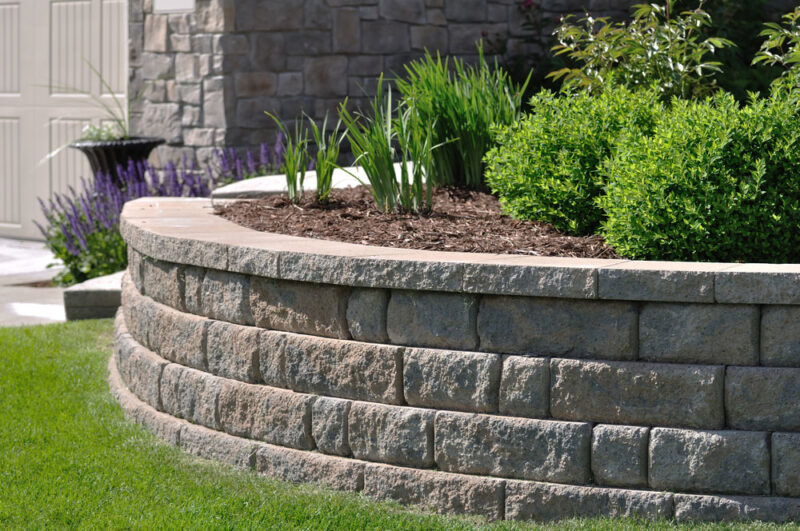While walls are often thought of as design elements, they can be useful for landscaping as well. Landscaping walls can be freestanding, serve as a garden backdrop, or used to create a private area. Landscaping walls can also be used to retain soil after an excavation project. In this particular case, they’re called “retaining walls.”
Retaining walls can be used to hold up sections of your yard and can be made of wood, masonry, poured concrete, or concrete blocks. While they do have a practical purpose, they can also give your yard design more aesthetic appeal. Building a retaining wall can be a DIY job, but it’s also hard work. It’s important to get the construction done properly. Otherwise, you’ll be making unnecessary repairs later on.

Retaining Wall Repair
Benefits of a Retaining Wall
Some of the benefits of a retaining wall can include the following:
- Reduced Runoff — Retaining walls can reduce the amount of runoff on your sloped lawns, which can cause all kinds of problems for your yard (including pooling water and soil movement). A retaining wall minimizes this problem by interrupting the steep slope of the yard.
- Improved Value — Having a retaining wall on your property can make it more appealing to potential buyers, so it can increase the value of your home. Even if you’re not thinking about selling the property anytime soon, it never hurts to invest in certain improvements.
- Aesthetic Appeal — A sloped backyard doesn’t have a lot of aesthetic appeal, and you can’t do a lot of planting if the yard is too steep. Installing a retaining wall will turn your backyard into a more attractive space, because you’ll have an area that’s better for landscaping.
- More Square Footage — Retaining walls can create a level space in an area of your yard that would otherwise have a natural slope. This will give you more square footage to work with, so your yard can have more space for landscaping and sitting areas (including patios and terraces).
- Erosion Prevention — A steep yard can create an ideal environment for erosion, because it will have more water runoff. This can cause erosion to happen more quickly, as soil from the top runs down with it.
Be sure to speak to a professional for more information.
Common Causes of Retaining Wall Problems
Retaining walls have to work a lot harder than freestanding walls. Aside from having to support their own weight, they also have to be resistant to the lateral forces caused by soil retention. This soil can get saturated with water, which can create a tremendous amount of force (especially with the slow-draining and expansive clay soil we have in the Coastal Bend). Special provisions have to be made when building a retaining wall, which will include the following:
- A batter (or pitch) is created, so it leans toward the soil it’s retaining.
- Tie-backs (which are also called “dead-man anchors”) are installed to tie the wall inside the soil located behind the wall.
- Drains are laid behind the foot of the wall, so water can be moved away before pressure can build up and push against the wall.
- Footings (which are beds of compacted gravel) are used to support the wall, especially if the soil is loose or is prone to freezing.
If the retaining wall has no batter, a problem with the anchors, drains that have become clogged, or a base that isn’t firm enough, a retaining wall can start to settle, tilt, or buckle. Tree roots can also add to the pressure. Even the weight of items placed on the ground above and behind the walls (such as parked vehicles or outbuildings) can add to the strain.
Options for Retaining Wall Repair
Whether it’s made of stone, block, concrete, or wood, a retaining wall can lean. When this happens, you have two choices. You can demolish the entire wall and re-excavate before reinstalling the drainage system and rebuilding the wall. But if you want a more cost-effective solution, you can have the wall repaired by calling a foundation repair expert. This person will be able to stabilize the wall. In many cases, it can be pulled back to its original position.
Foundation repair companies can fix foundation walls by using similar techniques, and one method that has gained widespread acceptance is the use of helical anchors. These helix-shaped blades are welded onto steel shafts, which forms an anchor that looks like a giant screw. Holes are cut into the wall, which are used to accommodate the blade’s diameter. Then, hydraulic rotary equipment is used to drive it into the wall and deep into the soil.
If you’re looking for one of the best places for foundation repair in Corpus Christi, be sure to get in touch with Streem Foundation Repair.
